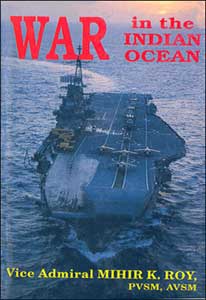The global trend for liberalization, both politically and economically, has also lent itself to a new oceanic approach where maritime forces will need to diffuse the existing psychology for ‘preparing for war in order to ensure peace’ which in a way was the colonial and cold war theme. The new cliche should instead be ‘if you desire peace prepare to cooperate’. In this emerging perception navies are best suited for assisting the United Nations to achieve victory in their skirmishes for peace. One could do no better than to quote Eric Groves that ‘naval forces lend themselves extremely well to international action. The more this can be put into a wider international security framework notably the security machinery of the UN, the better’.14
| Editor’s Pick |
India’s maritime policy must hence necessarily identify and implement policies for promoting regional understanding and cooperation in order to do away with popular cliches such as hegemonistic ambitions, blue water capability and big brother interventions. The ongoing trends in peace-making, peace keeping and peace-building along with preventive diplomacy will perforce remove India’s sea-blindness thus encouraging her to make effective use of the seas and the ingredients of the power of the seas. Delhi will need to forge stronger maritime, commercial and economic links with France, South Africa, Indonesia, Sri Lanka, Mauritius, Australia, Singapore and Malaysia and other littorals including Pakistan and Myanmar in course of time to break out of the present continental mindset.
Indias maritime policy must hence necessarily identify and implement policies for promoting regional understanding and cooperation in order to do away with popular cliches such as hegemonistic ambitions, blue water capability and big brother interventions.
In such a maritime environment, which spawns maritime strategies of nations, the sea and the sailors are a natural and readily available medium for bringing together the hearts and minds of like-minded nations which in turn will influence the texture of the country’s strategic, economic, cultural and industrial perceptions. Regional cooperation encompassing contemporary maritime strategy will perforce bring in their wake other cooperative programmes. This will further encourage multilateral understandings which are the precursor for regional cooperation thus enlarging the brotherhood of the seas for as the Norwegians say, ‘The land divides, but the seas unites.’
The sine qua non of the Indian Navy will therefore depend on a coherent maritime policy based on a correct understanding of international matrix and a sophisticated differentiation between the forces and factors that would help or hinder development. India’s maritime strategy should hence eliminate the fears of neighbours and defuse the factors that attract the attention of outside powers to intervene against India’s vital interests. An investment in national security will perforce be an investment in national development.
The challenge and dynamism of the seas to improve the standard of life and economic growth of developing continents may not be the single most important facet in the remaining decades of this century – but then it may. Therefore the emerging relationship between sea power and the power of the seas may well change the very basis of India’s strategic, economic and environmental security.
 It will therefore be opportune for India, sandwiched as it were between a new economic revival and an emerging world disorder to plan ahead for striding into the twenty first century and not remain becalmed in the Indian Ocean which Mahan had prophesied would be ‘the Ocean of Destiny in the twenty-first century’. So to conclude by taking refuge from India’s sea-blindness in the Navy’s motto:
It will therefore be opportune for India, sandwiched as it were between a new economic revival and an emerging world disorder to plan ahead for striding into the twenty first century and not remain becalmed in the Indian Ocean which Mahan had prophesied would be ‘the Ocean of Destiny in the twenty-first century’. So to conclude by taking refuge from India’s sea-blindness in the Navy’s motto:
Notes
- Asian Strategic Review, 1993-94, The Institute for Defence Studies and Analysis, Sapru House, Delhi, 1994, pp. 60-63.
- Dawn, Karachi, 11 June 1991.
- The Military Balance 1993-94, published by Brasseys for the International Institute for Strategic Studies, London, 9. 149.
- The Military Balance, 1993-94, p. 158.
- The Military Blance, 1993-94, p. 154.
- Asian Strategic Review, 1993-94, IDSA, New Delhi, Aughust 1994, p. 46.
- Eric Groves, Navies in Future Conflicts, p. 171.




